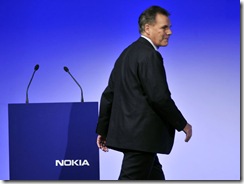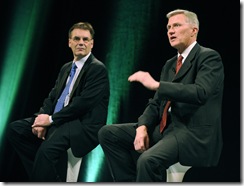When Jorma Ollila stepped down as Nokia CEO and chairman in 2006, his successor was always going to find it challenging to maintain the levels of success Ollila brought to the Finnish telecom manufacturer in his 13-year reign. Olli-Pekka Kallasvuo was that successor, a Nokia insider seen as a safe pair of hands. However, what has transpired over the past four years indicates that a safe pair of hands is no longer enough to survive and thrive in a brutally competitive global handset market
Kallasvuo made a dignified exit from Nokia after the board lost confidence in his ability to defend the company’s position from mounting competitive threats (Getty Images)
In the lead up to the appointment of Olli-Pekka Kallasvuo as president and CEO of Nokia in June 2006, he made it clear that it was not a job he had put himself up for, rather, should he be asked to take on the responsibility he would. A 26-year Nokia veteran at the time, Kallasvuo had enjoyed a number of senior management roles across the company, and in keeping with Nokia’s preference to appoint a Finnish insider as CEO, Kallasvuo duly succeeded charismatic Jorma Ollila.
The personalities of the two men were very different. Similar to former UK Prime Minister Tony Blair giving way to Gordon Brown, it was clear from the beginning that Kallasvuo possessed little of the charisma and personality of his predecessor, though he was an experienced, pragmatic manager. After all, it was Ollila who had turned Nokia around from its rubber company roots to becoming the leading mobile handset manufacturer in the world, by some measure.
Dynamism and not pragmatism is what Nokia now seeks, under pressure from shareholders and analysts alike to make up ground on Apple’s iPhone and Google’s Android mobile operating system (OS).
“The time is right to accelerate the company’s renewal; to bring in new executive leadership with different skills and strengths in order to drive company success,” Nokia’s board said in a statement, justifying its decision to part company with Kallasvuo. “The Nokia board believes that Stephen (Elop) has the right industry experience and leadership skills to realise the full potential of Nokia.”
It must be made clear that by no means is Kallasvuo leaving behind a company that is failing operationally. Net sales in Q210 to end-June amounted to €10 billion (US$14 billion), up one per cent year-on-year. Operating profit did decline 31 per cent year-on-year to €295 million in Q210, though total mobile device volumes increased eight per cent to 111.1 million during the period.
Nokia reported that its converged mobile device (smartphone and mobile computer) volume for the quarter stood at 24 million units for the quarter, up 42 per cent year-on-year. According to research house Gartner, these numbers translate to Nokia-owned Symbian operating system enjoying a 41.2 per cent market share of smartphone sales in Q210, and 34.2 per cent market share of all mobile devices shipped during the period.
So while Nokia’s market position remains pretty healthy on the whole, it is the pace at which the company’s competitors have been developing relative to Nokia that appears to have been at the centre of investor dissatisfaction with Nokia’s, and by extension, Kallasvuo’s overall performance.
Android’s market share of smartphone sales grew exponentially from 1.8 per cent in Q209 to 17.2 per cent in Q210, for example, with Symbian experiencing movement in the opposite direction, with smartphone market share declining from 51 per cent to 41.2 per cent.
Nokia’s efforts to rebound in the smartphone OS market were clear to see at the manufacturer’s Nokia World event held in London in the middle of September, where it announced three devices featuring its latest Symbian 3 software. The Nokia E7, Nokia C7 and Nokia C6 share the OS with the Nokia N8, which officially starting shipping at the end of September and is packed with entertainment features aimed at challenging iPhones.
Kallasvuo’s overriding strategy was to look to harness the personalisation of information on and through Nokia devices and the establishment of Ovi, Nokia’s online portal, was a significant pillar of this strategy.
Starting at the beginning of 2008, Nokia was also reordered into three units: devices – charged with manufacturing of handsets; services and software – which were to offer consumer Internet services and products for the enterprise market; and markets – which was to manage Nokia’s supply chain, sales and marketing.
Nokia expected the reorganisation to better manage its range of devices, speed up bringing new products to market, and increase marketing efficiency.
“The convergence of the mobile communications and Internet industries is opening up new growth opportunities for us, both in the devices business as well as in consumer Internet services and enterprise solutions,” Kallasvuo said at the time. “We believe this new organisation can capitalise on these opportunities while allowing us to increase the effectiveness of our investments and the efficiency of our operations.”
So while Nokia remains a solid business, it is Kallasvuo’s vision and strategy that has fallen short of expectations and resulted in the manufacturer’s share price being put under pressure for much of the latter stages of his tenure.
Since the beginning of 2006, Nokia’s share price rose from €16.33 to €26.89 in 2008, but has since dropped, and is currently languishing at €7.84 at the time of going to press. This represents a decline of over 50 per cent since the beginning of 2006.
“The problem Nokia faces is finding a European Steve Jobs to replace Kallasvuo,” commented Gartner VP Nick Jones, in July. “The new CEO needs the experience to run a company the size of Nokia, the charisma to pacify investors, the knowledge to recognise bad products and strategies, and the courage to kill them.” 
Ally Anssi Vanjoki (right) resigned shortly after the announcement of Kallasvuo’s departure. Vanjoki had been seen as a likely internal candidate for the top job at Nokia (Getty Images)
Jones also said he believed the new CEO would need to be someone already in the mobile space, because an outsider would take too long to get up to speed on how the business works. Stephen Elop – Kallasvuo’s replacement – appears to fit some of these criteria, though not all of them and it remains to be seen which direction he shall take the company.
Elop joins Nokia from Microsoft, a company he joined in January, 2008 as president of Microsoft Business Division.
Before Microsoft, Elop was COO of Juniper Networks where he was responsible for all the company’s product groups, corporate development, global sales and service and marketing and manufacturing organisations.
Prior to Juniper, Elop served as president of worldwide field operations at Adobe Systems, where he was responsible for Adobe’s global sales organisation and all customer-facing functions. Elop joined Adobe following the 2005 acquisition of Macromedia, where he was president and CEO.
Thus while Elop comes with plenty of corporate experience, only parts of it are likely to be relevant in the early stages of his role at Nokia. Coming straight from Microsoft, which is itself grappling with maintaining a reasonable presence in the mobile OS market, means that for much of Elop’s early days at Nokia he will have to learn as he goes.
In the middle of October Microsoft officially launched its new Windows Phone 7, an OS aimed at repairing damage caused by the poor performance of Windows Mobile Microsoft.
Unique features of the Windows 7 Phone include things such as a new Facebook and Xbox integration system, as well as a broad range of available applications, which the technology company hopes will raise its current smartphone OS market share above its current five per cent.
The appointment of an outsider at the helm of Nokia has already triggered internal fallouts that are likely to continue. Anssi Vanjoki, the Nokia executive in charge of smartphones and services, announced his resignation shortly after Elop’s appointment.
Vanjoki, who joined Nokia in 1991 has been head of Mobile Solutions since 2008, and has a six-month notice period.
“I felt the time has come to seek new opportunities in my life,” said Vanjoki, who had been considered the most likely internal candidate to replace Kallasvuo.
In early October, Ari Jaaksi, a senior Nokia executive in charge of its forthcoming MeeGo OS tendered his resignation. The MeeGo platform is a joint venture between Nokia and Intel and is aimed at high-end smartphones and potentially tablets.
Earlier this year, Nokia and Intel announced that they were to merge their respective mobile-Linux platforms, Maemo and Moblin to create a single open software platform called MeeGo. The announcement built on the companies’ collaboration announced last June.
In a statement, Nokia said Jaaksi had “decided to pursue opportunities outside of Nokia”.
While Nokia’s share price did rally somewhat on the news of Kallasvuo’s departure, it is by no means near its previous highs. The manufacturer is set to announce its third-quarter results on October 21, which will be the last that have a link to Kallasvuo. From there on out Elop and his senior management team are likely to busy themselves doing whatever’s necessary to maximise the impact of Nokia’s new products during the traditionally robust trading period that is the fourth quarter.





0 comments ↓
There are no comments yet...Kick things off by filling out the form below.
Leave a Comment